Mode Transition of Droplet Formation in a Semi-3D Flow-Focusing Microfluidic Droplet System †
Abstract
:1. Introduction
2. Materials and Methods
2.1. Experimental Design
2.1.1. Device Layout and Microfabrication
2.1.2. Microfluidic Emulsification
2.1.3. Characterization
2.2. Materials
3. Results and Discussion
3.1. Semi-3D Flow-Focusing Microfluidic Device
3.2. Droplets Formation
3.2.1. Droplet Breakup Processes
3.2.2. Uniformity Based on Pressure Ratio and Surfactant
3.3. Transition from Jetting to Dripping Mode
3.4. Discussion
4. Conclusions
Supplementary Materials
Acknowledgments
Author Contributions
Conflicts of Interest
References
- Xiao, Q.; Ji, Y.; Xiao, Z.; Zhang, Y.; Lin, H.; Wang, Q. Novel multifunctional NaYF4:Er3+,Yb3+/PEGDA hybrid microspheres: Nir-light-activated photopolymerization and drug delivery. Chem. Commun. 2013, 49, 1527–1529. [Google Scholar] [CrossRef] [PubMed]
- Wang, L.H.; Zhang, J.; Wang, X. Gold nanoparticle-based optical probes for target-responsive DNA structures. Gold Bull. 2008, 41, 37–40. [Google Scholar] [CrossRef]
- Pan, M.; Kim, M.; Blauch, L.; Tang, S.K.Y. Surface-functionalizable amphiphilic nanoparticles for pickering emulsions with designer fluid–fluid interfaces. RSC Adv. 2016, 6, 39926–39932. [Google Scholar] [CrossRef]
- Zhang, L.; Feng, Q.; Wang, J.; Sun, J.; Shi, X.; Jiang, X. Microfluidic synthesis of rigid nanovesicles for hydrophilic reagents delivery. Angew. Chem. 2015, 54, 3952–3956. [Google Scholar] [CrossRef] [PubMed]
- Shembekar, N.; Chaipan, C.; Utharala, R.; Merten, C.A. Droplet-based microfluidics in drug discovery, transcriptomics and high-throughput molecular genetics. Lab Chip 2016, 16, 1314–1331. [Google Scholar] [CrossRef] [PubMed]
- Moon, B.U.; Abbasi, N.; Jones, S.G.; Hwang, D.K.; Tsai, S.S. Water-in-water droplets by passive microfluidic flow focusing. Anal. Chem. 2016, 88, 3982–3989. [Google Scholar] [CrossRef] [PubMed]
- Ward, T.; Faivre, M.; Stone, H.A. Drop production and tip-streaming phenomenon in a microfluidic flow-focusing device via an interfacial chemical reaction. Langmuir 2010, 26, 9233–9239. [Google Scholar] [CrossRef] [PubMed]
- Kim, H.; Luo, D.; Link, D.; Weitz, D.A.; Marquez, M.; Cheng, Z. Controlled production of emulsion drops using an electric field in a flow-focusing microfluidic device. Appl. Phys. Lett. 2007, 91, 133106. [Google Scholar] [CrossRef]
- Yobas, L.; Martens, S.; Ong, W.L.; Ranganathan, N. High-performance flow-focusing geometry for spontaneous generation of monodispersed droplets. Lab Chip 2006, 6, 1073–1079. [Google Scholar] [CrossRef] [PubMed]
- Moyle, T.M.; Walker, L.M.; Anna, S.L. Controlling thread formation during tipstreaming through an active feedback control loop. Lab Chip 2013, 13, 4534–4541. [Google Scholar] [CrossRef] [PubMed]
- Tang, S.Y.; Joshipura, I.D.; Lin, Y.; Kalantar-Zadeh, K.; Mitchell, A.; Khoshmanesh, K.; Dickey, M.D. Liquid-metal microdroplets formed dynamically with electrical control of size and rate. Adv. Mater. 2016, 28, 604–609. [Google Scholar] [CrossRef] [PubMed]
- Jeong, W.C.; Lim, J.M.; Choi, J.H.; Kim, J.H.; Lee, Y.J.; Kim, S.H.; Lee, G.; Kim, J.D.; Yi, G.R.; Yang, S.M. Controlled generation of submicron emulsion droplets via highly stable tip-streaming mode in microfluidic devices. Lab Chip 2012, 12, 1446–1453. [Google Scholar] [CrossRef] [PubMed]
- Peng, L.; Yang, M.; Guo, S.S.; Liu, W.; Zhao, X.Z. The effect of interfacial tension on droplet formation in flow-focusing microfluidic device. Biomed. Microdevices 2011, 13, 559–564. [Google Scholar] [CrossRef] [PubMed]
- Anna, S.L.; Mayer, H.C. Microscale tipstreaming in a microfluidic flow focusing device. Phys. Fluids 2006, 18, 121512. [Google Scholar] [CrossRef]
- Yu, C.; Qian, X.; Chen, Y.; Yu, Q.; Ni, K.; Wang, X. Three-dimensional electro-sonic flow focusing ionization microfluidic chip for mass spectrometry. Micromachines 2015, 6, 1890–1902. [Google Scholar] [CrossRef]
- Oh, K.W.; Lee, K.; Ahn, B.; Furlani, E.P. Design of pressure-driven microfluidic networks using electric circuit analogy. Lab Chip 2012, 12, 515–545. [Google Scholar] [CrossRef] [PubMed]
- Stan, C.A.; Tang, S.K.Y.; Whitesides, G.M. Independent control of drop size and velocity in microfluidic flow-focusing generators using variable temperature and flow rate. Anal. Chem. 2009, 81, 2399–2402. [Google Scholar] [CrossRef] [PubMed]
- Kurdzinski, M.E.; Gol, B.; Hee, A.C.; Thurgood, P.; Zhu, J.Y.; Petersen, P.; Mitchell, A.; Khoshmanesh, K. Dynamics of high viscosity contrast confluent microfluidic flows. Sci. Rep. 2017, 7, 5945. [Google Scholar] [CrossRef] [PubMed]
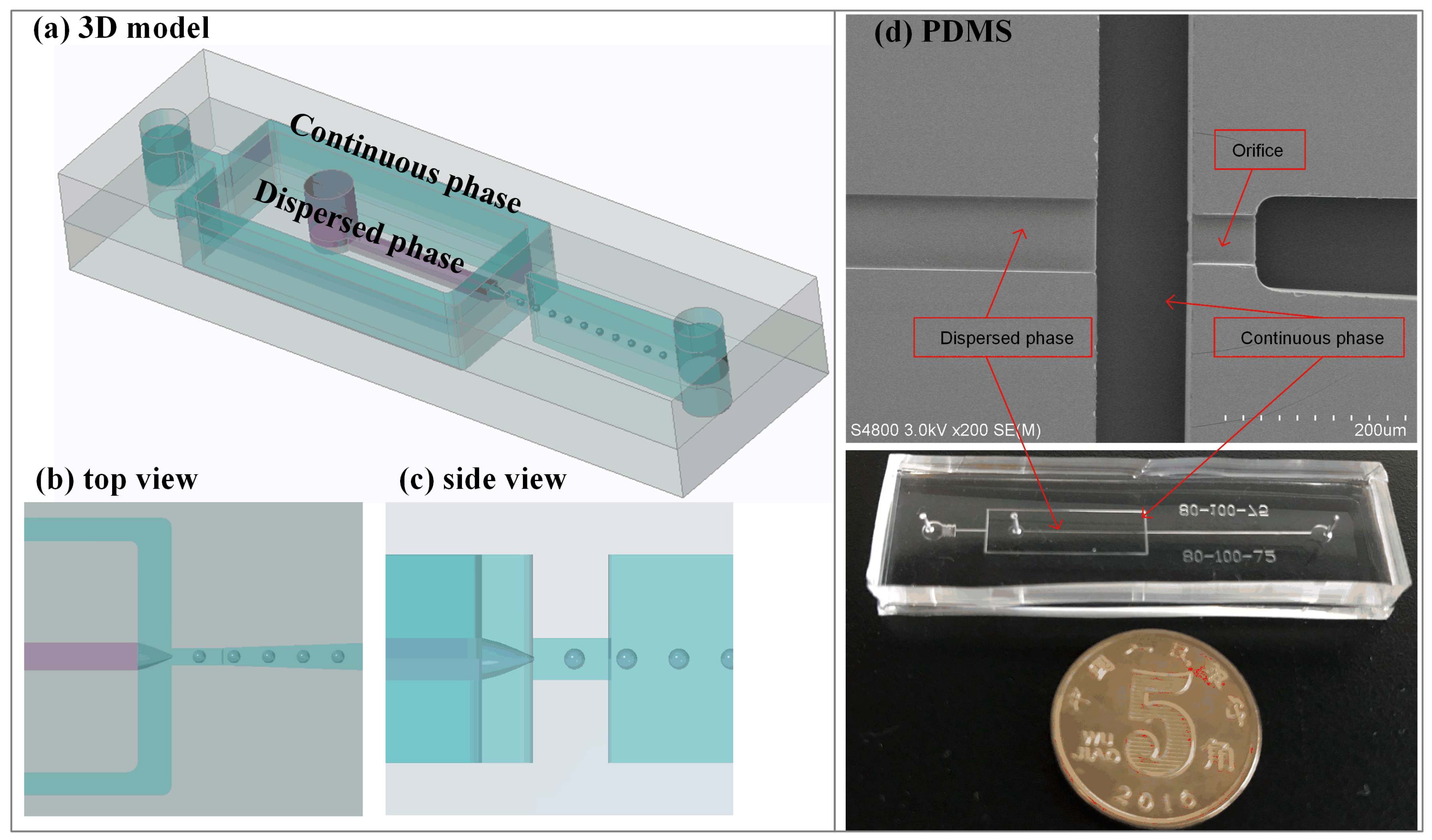


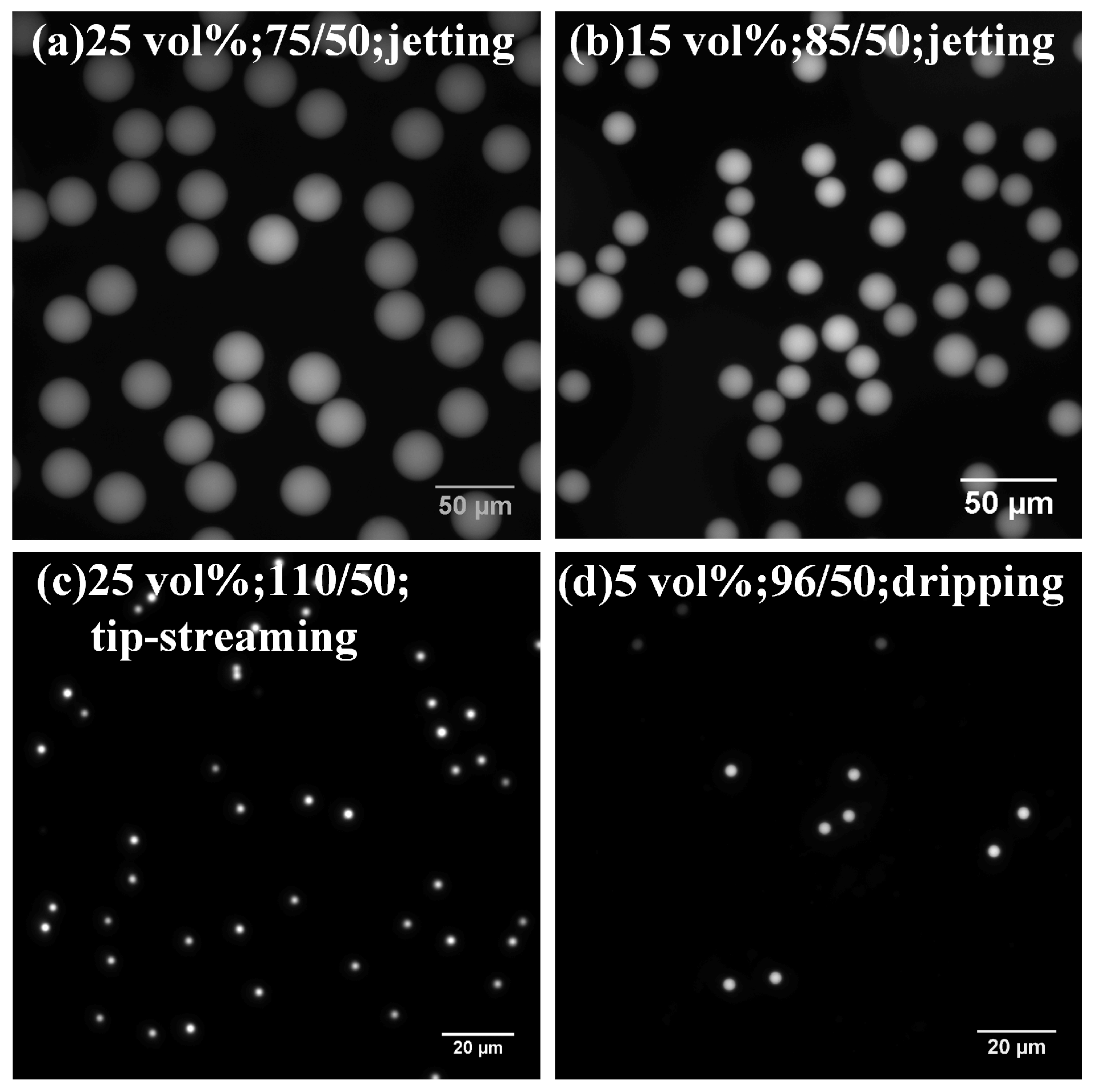



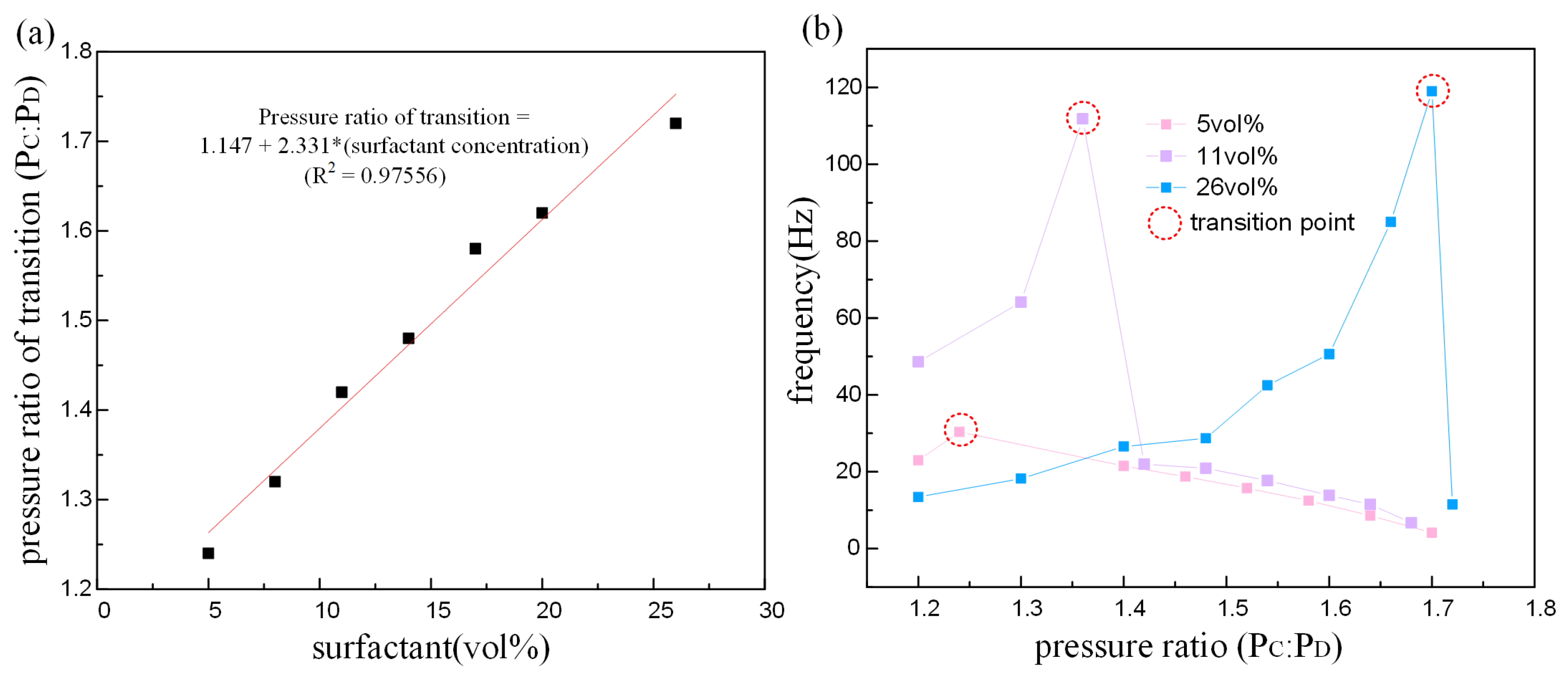
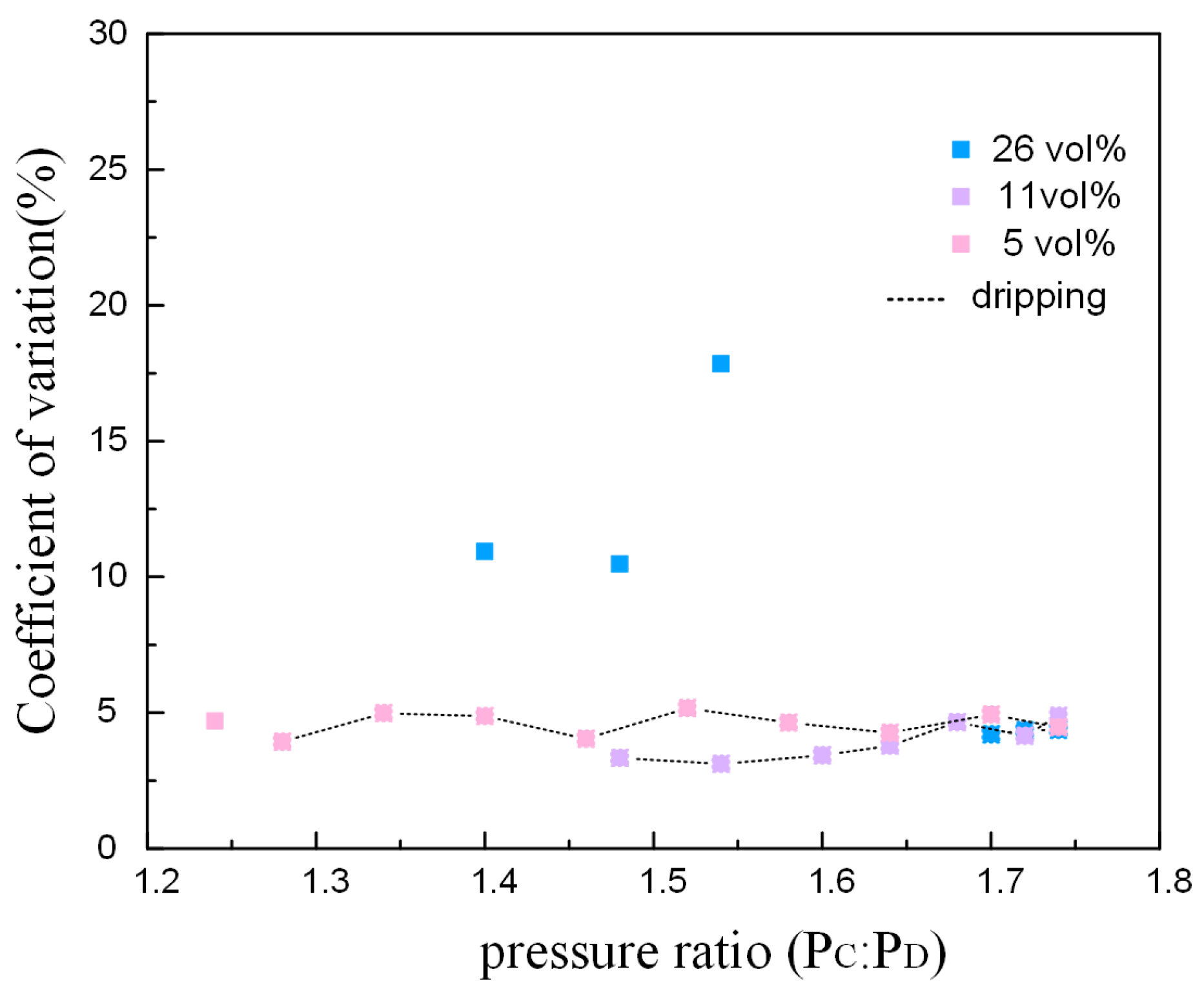
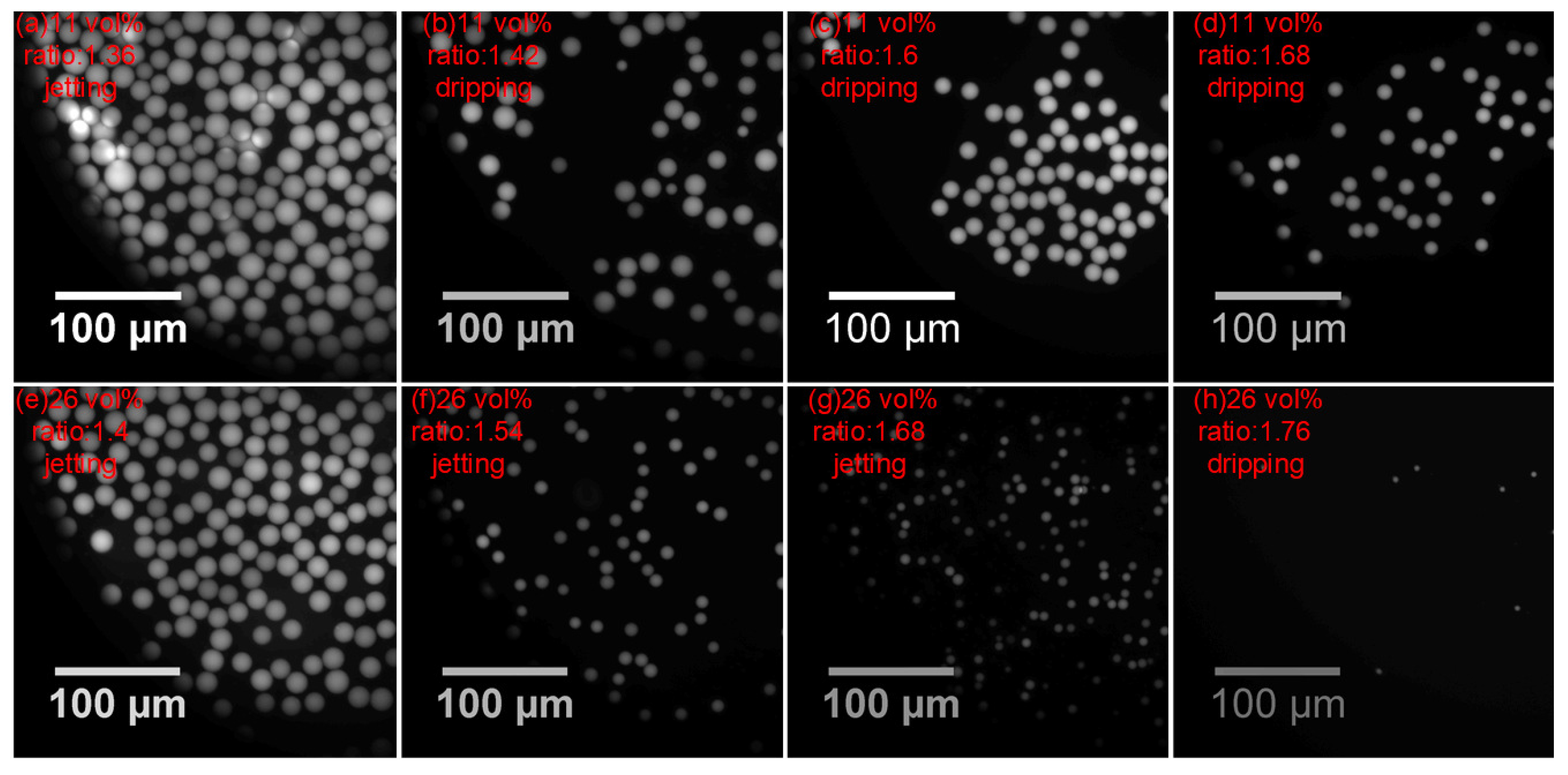

| Surfactant Concentration | Mode Transition | Pressure Ratio of Transition |
|---|---|---|
| 5 vol % | jetting to dripping | 1.8 |
| 10 vol % | jetting to dripping | 1.9 |
| 15 vol % | jetting to tip-streaming | 2.03 |
| 20 vol % | jetting to tip-streaming | 2.1 |
| 25 vol % | jetting to tip-streaming | 2.2 |
© 2018 by the authors. Licensee MDPI, Basel, Switzerland. This article is an open access article distributed under the terms and conditions of the Creative Commons Attribution (CC BY) license (http://creativecommons.org/licenses/by/4.0/).
Share and Cite
Wu, Y.; Qian, X.; Zhang, M.; Dong, Y.; Sun, S.; Wang, X. Mode Transition of Droplet Formation in a Semi-3D Flow-Focusing Microfluidic Droplet System. Micromachines 2018, 9, 139. https://doi.org/10.3390/mi9040139
Wu Y, Qian X, Zhang M, Dong Y, Sun S, Wang X. Mode Transition of Droplet Formation in a Semi-3D Flow-Focusing Microfluidic Droplet System. Micromachines. 2018; 9(4):139. https://doi.org/10.3390/mi9040139
Chicago/Turabian StyleWu, Yan, Xiang Qian, Min Zhang, Ying Dong, Shuqing Sun, and Xiaohao Wang. 2018. "Mode Transition of Droplet Formation in a Semi-3D Flow-Focusing Microfluidic Droplet System" Micromachines 9, no. 4: 139. https://doi.org/10.3390/mi9040139





